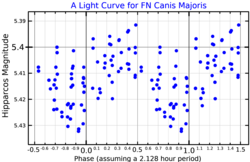 A light curve for FN Canis Majoris from Hipparcos data. Adapted from Rivinius et al. (2011) | |
| Observation data Epoch J2000.0 Equinox J2000.0 | |
|---|---|
| Constellation | Canis Major |
| Right ascension | 07 06 40.76672 |
| Declination | −11° 17′ 38.4396″ |
| Apparent magnitude (V) | 5.41 (5.69 + 7.04) |
| Characteristics | |
| Spectral type | B0 III/IV or B2 Ia/ab |
| B−V color index | 0.033±0.004 |
| Astrometry | |
| Radial velocity (Rv) | +31.0±4.2 km/s |
| Proper motion (μ) | RA: −3.14±0.72 mas/yr Dec.: +3.32±0.55 mas/yr |
| Parallax (π) | 1.07 ± 0.61 mas |
| Distance | approx. 3,000 ly (approx. 900 pc) |
| Details | |
| Mass | 19.23±1.85, 24.0±0.1, 35.5±4.6 M☉ |
| Luminosity (bolometric) | 122,079, 690,000 L☉ |
| Surface gravity (log g) | 3.59±0.11 cgs |
| Temperature | 26,850, 33,600±1,840 K |
| Rotational velocity (v sin i) | 100±9 km/s |
| Age | 6.0±0.1 Myr |
| Other designations | |
| FN CMa, BD−11°1790, GC 9389, HD 53974, HIP 34301, HR 2678, SAO 152394, WDS J07067-1118 | |
| Database references | |
| SIMBAD | data |
FN Canis Majoris is a binary star system in the southern constellation Canis Major, near the northern constellation border with Monoceros. It is dimly visible to the naked eye with a combined apparent visual magnitude of 5.41. The system is located at a distance of approximately 3,000 light years from the Sun based on parallax, and is drifting further away with a radial velocity of +31 km/s. It is a runaway star associated with the Sh 2-296 nebula in the CMa OB1 association, and has a conspicuous bow-shock feature.
The brighter component is a visual magnitude 5.69 B-type star that has been assigned various stellar classification from B0 III/IV to B2 Ia/ab, suggesting it is an evolved state. In 1967, Graham Hill announced his discovery that the star, then known as HD 53974, is a variable star. It was given its variable star designation, FN Canis Majoris, in 1970. In the past it was classified as a Beta Cephei type variable star with an apparent magnitude that was measured varying between +5.38 and +5.42 over a period of 36.7 hours, but is no longer considered to be one. This is a massive star with estimates ranging from 19 to 36 times the mass of the Sun, and luminosity estimates of 122,079 to 690,000 times the Sun's luminosity. The magnitude 7.04 companion is located at an angular separation of 0.60″ from the primary at a position angle of 111°, as of 2003.
References
- Rivinius, Th.; Stahl, O.; Štefl, S.; Baade, D.; Townsend, R. H. D.; Barrera, L. (July 2011). "The (B0+?)+O6 system FN CMa: a case for tidal-pulsational interaction?". Proceedings IAU Symposium. 272: 543–544. arXiv:1009.3512. Bibcode:2011IAUS..272..543R. doi:10.1017/S1743921311011380.
- ^ van Leeuwen, F. (2007). "Validation of the new Hipparcos reduction". Astronomy and Astrophysics. 474 (2): 653–664. arXiv:0708.1752. Bibcode:2007A&A...474..653V. doi:10.1051/0004-6361:20078357. S2CID 18759600.
- ^ Anderson, E.; Francis, Ch. (2012). "XHIP: An extended hipparcos compilation". Astronomy Letters. 38 (5): 331. arXiv:1108.4971. Bibcode:2012AstL...38..331A. doi:10.1134/S1063773712050015. S2CID 119257644.
- ^ Eggleton, P. P.; Tokovinin, A. A. (2008). "A catalogue of multiplicity among bright stellar systems". Monthly Notices of the Royal Astronomical Society. 389 (2): 869. arXiv:0806.2878. Bibcode:2008MNRAS.389..869E. doi:10.1111/j.1365-2966.2008.13596.x. S2CID 14878976.
- ^ Tjin A Djie, H. R. E.; et al. (August 2001). "The stellar composition of the star formation region CMa R1 - II. Spectroscopic and photometric observations of nine young stars". Monthly Notices of the Royal Astronomical Society. 325 (4): 1441–1457. arXiv:astro-ph/0103349. Bibcode:2001MNRAS.325.1441T. doi:10.1046/j.1365-8711.2001.04541.x. S2CID 117112792.
- ^ Fernandes, B.; et al. (August 2019). "Runaways and shells around the CMa OB1 association". Astronomy & Astrophysics. 628: 15. arXiv:1906.00113. Bibcode:2019A&A...628A..44F. doi:10.1051/0004-6361/201935484. S2CID 173990935. A44.
- ^ Hohle, M. M.; et al. (2010). "Masses and luminosities of O- and B-type stars and red supergiants". Astronomische Nachrichten. 331 (4): 349–360. arXiv:1003.2335. Bibcode:2010AN....331..349H. doi:10.1002/asna.200911355. S2CID 111387483.
- ^ Tetzlaff, N.; et al. (January 2011), "A catalogue of young runaway Hipparcos stars within 3 kpc from the Sun", Monthly Notices of the Royal Astronomical Society, 410 (1): 190–200, arXiv:1007.4883, Bibcode:2011MNRAS.410..190T, doi:10.1111/j.1365-2966.2010.17434.x, S2CID 118629873
- ^ Zorec, J.; et al. (November 2016). "Critical study of the distribution of rotational velocities of Be stars. I. Deconvolution methods, effects due to gravity darkening, macroturbulence, and binarity". Astronomy & Astrophysics. 595: 26. Bibcode:2016A&A...595A.132Z. doi:10.1051/0004-6361/201628760. hdl:11336/37946.
- "FN CMa". SIMBAD. Centre de données astronomiques de Strasbourg. Retrieved 2020-03-09.
- ^ Hill, Graham (August 1967). "On Beta Cephei Stars: a Search for Beta Cephei Stars". Astrophysical Journal Supplement. 14: 263–300. Bibcode:1967ApJS...14..263H. doi:10.1086/190156. ISSN 0067-0049. Retrieved 1 January 2025.
- Kukarkin, B. V.; Kholopov, P. N.; Perova, N. B. (October 1970). "57th Name-List of Variable Stars" (PDF). Information Bulletin on Variable Stars. 480: 1–39. Bibcode:1970IBVS..480....1K. Retrieved 1 January 2025.
- Lefèvre, L.; Marchenko, S. V.; Moffat, A. F. J.; Acker, A. (2009). "A systematic study of variability among OB-stars based on HIPPARCOS photometry" (PDF). Astronomy and Astrophysics. 507 (2): 1141–1201. Bibcode:2009A&A...507.1141L. doi:10.1051/0004-6361/200912304. ISSN 0004-6361.
- Stankov, Anamarija; Handler, Gerald (2005). "Catalog of Galactic β Cephei Stars". The Astrophysical Journal Supplement Series. 158 (2): 193–216. arXiv:astro-ph/0506495. Bibcode:2005ApJS..158..193S. doi:10.1086/429408. ISSN 0067-0049. S2CID 119526948.
- Mason, B. D.; et al. (2014), "The Washington Visual Double Star Catalog", The Astronomical Journal, 122 (6): 3466–3471, Bibcode:2001AJ....122.3466M, doi:10.1086/323920.
| Constellation of Canis Major | |||||||||||||
|---|---|---|---|---|---|---|---|---|---|---|---|---|---|
| Stars |
| ||||||||||||
| |||||||||||||
| Star clusters |
| ||||||||||||
| |||||||||||||
| Galaxies |
| ||||||||||||
| |||||||||||||